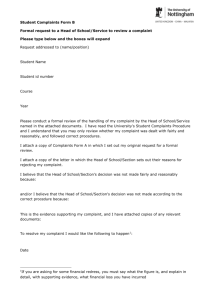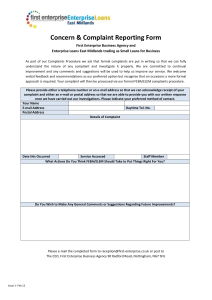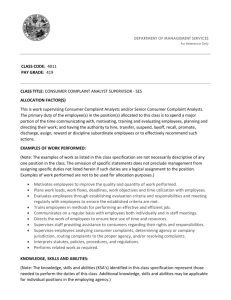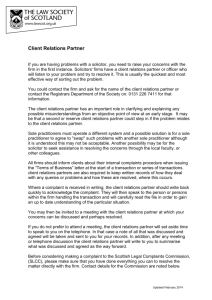Cultural Sensitivity and Civil Rights Training PowerPoint
advertisement
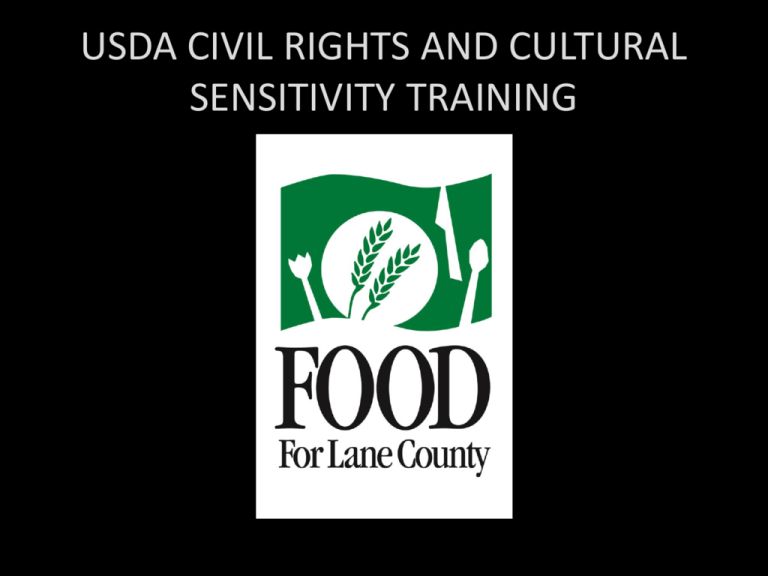
USDA CIVIL RIGHTS AND CULTURAL SENSITIVITY TRAINING GOALS • Provide you with a context to have greater awareness and sensitivity to people from other cultures. • Help you incorporate the concepts you learn as it affects customer service. • Familiarize you with the rules regarding Civil Rights Compliance. Dignity and Respect for ALL Cultural Sensitivity Civil Rights Dignity and Respect for ALL Cultural Sensitivity Civil Rights cul·ture /ˈkəlCHər/ noun 1. values, assumptions, and perceptions that are expressed in the way we behave and act. 2. the customary beliefs and perceptions of a racial, religious, or social group. 3. the characteristic features of everyday existence shared by people in a place or time. cul·tur·al sen·si·tiv·i·ty \ˈkəlch-rəl ˌsen(t)-sə-ˈti-və-tē\ noun 1. a set of skills that enables you to learn about and get to know people who are different from you, thereby coming to understand how to serve them better. Cultural Sensitivity impacts the way we serve people What defines your culture? Race/Ethnicity Income Level Neighborhood Language Religion Cultural Sensitivity in Action Latino Culture • Head nodding • Eye Contact • Personal Space Poverty Culture • Work ethic • Opportunities • Budgeting • Oral communication Asian Culture • Education • Respect for ancestors and Elderly • Importance of Family Alterability Culture • Not defined by disability • Resilience • Greatly varied • Don’t judge a book by its cover Cultural Sensitivity Cultural Competence Dignity and Respect for ALL Cultural Sensitivity Civil Rights Purpose of Civil Rights Dignity and Respect for All Equal Treatment Rights and Responsibilities Elimination of Illegal Barriers Customer Service • Marital Status • Familial or Parental Status • Sexual Orientation • Genetic Information • Income • Political Beliefs Other Considerations • Race • Color • National Origin • Age • Disability • Sex • Gender Identity • Religion • Reprisal Accepted in Oregon Accepted Nationally Protected Bases • Immigration Status • Ethnicity • Education • Geographical Location • Poverty • Ability to Care for Oneself Alterabilities Seeing Hearing Walking Breathing Thinking/Cognitive Caring for Oneself Special Needs Clients and Reasonable Accommodations Types of Discrimination Differential Treatment Disparate Impact Reprisal or Retaliation Differential Treatment Refusing Service Different eligibility for certain applicants Disparate Impact Discrimination that is not intentional, but has that effect A rule that impacts a protected class disproportionately Reprisal or Retaliation Negative treatment of someone because of a complaint Denial of service, harassment, intimidation, etc. Civil Rights Compliance Requirements Requirements Annual Training Limited English Public Notification Proficiency Plan Filing Complaints Requirements Annual Training Limited English Public Notification Proficiency Plan Filing Complaints Annual Training Requirements Annual Training Limited English Public Notification Proficiency Plan Filing Complaints Public Notification Inform FOOD for Lane County and the public of temporary or permanent changes in programs Provide alternative formats for persons with disabilities or with Limited English Proficiency Post Justice for All poster where clients can see it Include Non-Discrimination Statement on all websites and publications Non-Discrimination Statement “The U.S. Department of Agriculture prohibits discrimination against its customers on the bases of race, color, national origin, age, disability, sex, gender identity, religion, reprisal, and where applicable, political beliefs, marital status, familial or parental status, sexual orientation, or all or part of an individual’s income is derived from any public assistance program, in any program or activity conducted or funded by the Department. (Not all prohibited bases will apply to all programs and/or employment activities.) If you wish to file a civil Rights program complaint of discrimination, complete the USDA Program Discrimination Complaint Form, found online at http://www.ascr.usda.gov/complaint_filing_cust.htm, or at any USDA office, or call (866) 632-9992 to request the form. You may also write a letter containing all of the information requested in the form. Send your completed complaint form or letter to us by mail at U.S. Department of Agriculture, Director, Office of Adjudication, 1400 Independence Avenue, S.W., Washington, D.C. 20250-9410, by fax (202) 690-7442 or email at program.intake@usda.gov. Individuals who are deaf, hard of hearing or have speech disabilities may contact USDA through the Federal Relay Service at (800) 877-8339; or (800) 845-6136 (Spanish).” Non-Discrimination Statement “This institution is an equal opportunity provider” Menus Door flyers Websites Calendars Newsletters Brochures Requirements Annual Training Limited English Public Notification Proficiency Plan Filing Complaints Limited English Proficiency Plans 2013 Cultural Demographics of Oregon A strategy to identify persons who need language assistance Provide meaningful assistance to those with Limited English Proficiency Best Practices for LEP Plans Bilingual/Bicultural staff or volunteers Bilingual material in the lobby Frontline bilingual support Double-sided or individual bilingual forms Bilingual building signage Special aid to clients with limited reading proficiency Requirements Annual Training Limited English Public Notification Proficiency Plan Filing Complaints Types of Complaints Customer Service Civil Rights Handling Civil Rights Complaints Address the complaint Be patient, listen, and breathe Be understanding Explain the program rules Assist with a complaint form Get client contact info Clearly explain who, what, when, and why You must fill out the complaint form if they refuse Assist in resolution Notify FOOD for Lane County and Oregon Housing and Community Services Identify ways to prevent discrimination or perceived discrimination from happening again To reduce the risk of a Civil Rights Complaint, ask yourself the following questions each time a client comes into your program. Am I treating this person in the same manner that I treat all others? Have I checked Have I clearly my personal communicated assumptions program rules about this and client? expectations? Dignity and Respect for ALL To reduce the risk of a Civil Rights Complaint, ask yourself the following questions each time a client comes into your program. Am I treating this person in the same manner that I treat all others? Have I checked Have I clearly my personal communicated assumptions program rules about this and client? expectations? Dignity and Respect for ALL To reduce the risk of a Civil Rights Complaint, ask yourself the following questions each time a client comes into your program. Am I treating this person in the same manner that I treat all others? Have I checked Have I clearly my personal communicated assumptions program rules about this and client? expectations? Dignity and Respect for ALL “It is better to help one person who might ‘not really need it’, than to turn away one person who really does.” -Anonymous
